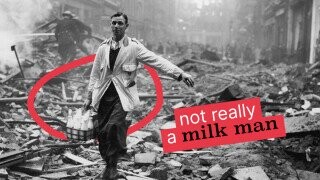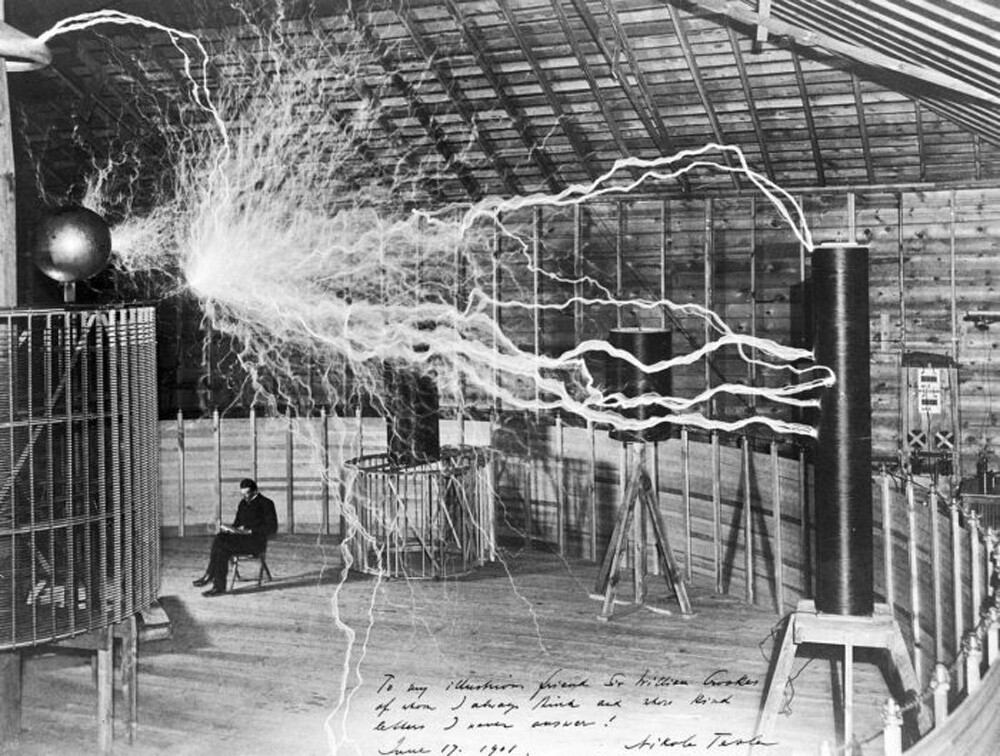5 Iconic Photos That Were Secretly Faked

A wise man once said, “The camera never lies.” That man was lying.
In fact, we were also lying when we attributed the line to a wise man. We have no idea what the origin of that line was. We also lied when we said the camera really does lie, because the camera does not lie. People simply use the camera to lie, as they did with the following famous images.
No, That Milkman Isn’t Keeping Calm and Carrying On

Fred Morely
During The Blitz, Germany bombed London night after night, and we all remember how the British spirit remained unbroken. In fact, when people weren’t huddled in their homes in total darkness to avoid attracting the attention of armed aircraft, they went about their daily lives, right? As exemplified by this famous photograph by Fred Morely, dated to October 9, 1940, which shows a milkman continuing to make his rounds amid all the destruction.
Except, that’s not really a milkman. That’s one of Morely’s assistants, in a milkman costume, posing for the camera. People in this particular frame really were tending to a fire but were not collectedly making deliveries. When you think about it, if a milkman did choose to make his deliveries on this day in this area, he probably wouldn’t be going along the road by walking right down the middle like that.
Morely claimed that his goal wasn’t to enforce the government’s “keep calm and carry on” message, even if that’s how people interpret the photo now. He wanted to capture the destruction. Wartime censors, he figured, would not let such a demoralizing photo circulate, but toss in a cool model, and it’d get his majesty’s approval, letting people still catch sight of the truth in the background.
That’s No Nuclear Mushroom Cloud

US Army
This an undoctored photo. It really does show the view above Hiroshima on August 6, 1945, the day a 15-kiloton nuke hit the city. Because of this, naturally, it’s often labeled as a photograph of the nuclear strike. Even the Hiroshima Peace Memorial Museum (as of 2016) labels it that way. And yet, that’s not what it is.
The photo shows the city more than three hours after the bombing. The original nuclear boom didn’t just chill there in the air till the afternoon. Instead, this is a separate plume of smoke that formed from the firestorm following the explosion. The instense temperatures from the explosion lasted just a few seconds, but they set hundreds of fires, which pulled in 40 mph winds that created their own burning weather system, lasting for hours.
It’s the aftermath of the nuke either way; we’re not here to defend nuclear strikes. But if you’re interested in how nuclear attacks work, you might be intrigued to learn that a nuke even a thousand times as big as Little Boy wouldn’t produce a mushroom cloud the size of the pictured one. Photos can show how intense the Hiroshima bombing was, but a photo with this scope would show just the wimpiest of clouds.
They Touched Up This Photo to Hide the Looting

Yevgeny Khaldei
This photo from May 2, 1945, is known as “Raising the Flag Over the Reichstag.” The Battle of Berlin came to a close, the Soviets beat the Germans, and this photo commemorates the victory. But it’s no candid shot of a battle’s climactic moment. The Soviets deliberately arranged this tableau, purposely trying to imitate an inspirational American photo they’d seen. That photo: “Raising the Flag on Iwo Jima” (which was not staged, but was manipulative in its own way).
The propaganda around this photo continued in the editing room. The photographer, Yevgeny Khaldei, worked for the news agency Tass, who noticed that a soldier in the photo wore two watches. No one wears two watches unless they’re fresh off a looting spree, so Tass erased one of them. Then Khaldei went back over the photo and added the extra smoke you now see, to make the scene look more dramatic.
Also, it turns out that raising a flag doesn’t definitively end a battle, because armies don’t follow playground rules. The day after this photo, Germans retook the Reichstag and removed the flag, and after that, Soviets had to take the building once more.
That Big Part’s Above Water

Ralph Clevenger
This famous photo depicts a most devious property of icebergs: That 90 percent of the ice lies below the water’s surface. You might have seen this image in motivational posters if you’re hanging out somewhere that hasn’t redecorated in a while. You also see it as the thumbnail for “iceberg” trivia videos. Such videos contain info of increasing obscurity, to trick you into sitting through facts you already know in hopes of reaching the tiny part of the video that’s interesting.
The photo looks a bit unreal. You might think it’s an illustration and not a photo at all. If so, let’s inspire you by revealing that it is a composite photo, meaning that every segment of the photo is something that nature photographer Ralph Clevenger actually captured with his camera. The process of compositing such an image really is impressive. The iceberg combines two different photos, one that he took in Alaska, and one that he took in Antarctica. The clouds and water, meanwhile, are two other different photos, both from California.
Just one little hitch, though: That huge ice mass under the water? Clevenger took that above the water, and then he inverted the image and placed it at the bottom of his photo. The color is real, no tinting was necessary to make it look all underwatery, but it doesn’t show ice lurking below because that ice in real life isn’t below anything. Turns out it’s physically impossible to capture the entirety of an iceberg, because we’re forced to obey the laws of optics.
Still, if you really love the stat that an iceberg is nine times bigger below the surface, don’t worry. That fact is still true. Now picture the photo’s bottom half floating above the water in Alaska, and imagine how huge its bottom must be. Not quite as huge as yo’ momma’s, but still.
Tesla’s Not Really Chilling With Lightning Here

Dickenson V. Alley
At the end of the 19th century, scientists like Edison and Westinghouse were warring over what sort of electricity works best. Meanwhile, Nikola Tesla (who was in the Westinghouse camp) was playing around with a kind of electricity transmission that sounded insane. He had something called a magnifying transmitter, which... well, sources dispute exactly what it did.
It was a novel system of transmitting electricity, said Tesla. It was a world-changing invention, he said. Or maybe it was just one of his Tesla coil circuits with an added kink, with very little possible real-world use. But while you won’t find many sources going into detail about the applications of his magnifying transmitter, you’ll find a whole lot reproducing the above image, of the man calmly reading in his Colorado Springs lab while the device was sparking madly. Whatever it was, it had to be safer than it looked, since the inventor stayed so close to it. Either that, or Tesla had balls of steel (note: balls of steel are excellent components for building a resonant transformer circuit).
That’s actually a publicity photo. Tesla was never sitting in the room like that while the infernal machine was operating. They took one photo of him seated in the room on that chair. Then they took a second photo of the machine in action on that same photographic plate, for a double exposure, adding in the millions of volts of celestial fury.
Wow, Tesla sometimes deceived people for the sake of building his image? Good thing no one associates that sort of chicanery with his name today.
Follow Ryan Menezes on Twitter for more stuff no one should see.